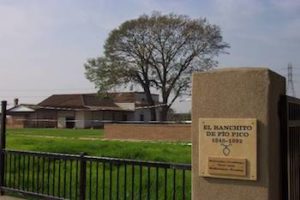
Pico State Park
The construction of the Pico House in 1854 is celebrated on this date. This was one of the many municipalities built and maintained by Blacks as Southern California emerged as a state (founded in 1850).
The city of Los Angeles has a deep story in Black history. The historic park, "Pueblo de Los Angeles" and "The Pico House," are landmarks honoring that history, dating back to the 17th century. When the Spanish authorities in Mexico began to recruit settlers for a new farming community in Alta, California, they concentrated their efforts on a poor area in Sinaloa. The purpose of the new colony was to heighten the Spanish presence in the area and to raise food for the nearby military garrisons.
The offer of free land sounded good to the population of the village of Rosario, and a group of 44 settlers arrived in the area late in the summer of 1781. Census figures show that two-thirds of the Rosario population was listed as mulattoes. According to a 1988 study by the curator of history at the Los Angeles Afro-American Museum, 26 of these first settlers were either Black or of mixed ancestry. Over time, racial identification dwindled. When California became a state, Los Angeles had a population of 1,598. Many descendants of the original settlers were among those who had become prominent in the city and acquired vast land grants.
Pio de Jesus Pico (1801-1894), the last Mexican governor of California, was the grandson of a mulatto settler. In photographs, Pico is shown to be dark, with broad features that show his Afro-Spanish origins. His ancestry was African, American Indian, Hispanic, and European. He rose from poverty to become one of the wealthiest men in California and, for a time, held the highest political office in Mexican California. He was part of the government of Mexican California from about 1828 until California became a state in 1850. In the 1830s and 1840s, he was a revolutionary dedicated to changing the departmental government to meet the desire of many Californians for republican rule. This meant frequent clashes with the representatives of the supreme government in Mexico.
This led to his position as governor from 1845 until the Americans took over in 1846. He fled to Mexico to prevent the conquering Americans from capturing him and taking him prisoner. Following the Treaty of Guadalupe Hidalgo, Pico became a private citizen and a successful businessman, and served on the Los Angeles City Council. One of Los Angeles's major thoroughfares, Pico Boulevard, is named for him. He built and owned Los Angeles's first central hotel, the Pico House, in 1870, located in the El Pueblo de Los Angeles (Olvera St). Around 1850, Pio Pico bought the Rancho Paso de Bartolo Viejo from the heirs of Juan Crispin Perez. El Ranchito (Pio Pico Mansion) was a gathering place for his neighbors and business acquaintances traveling large distances between settlements. Pio Pico Mansion is a small adobe home, but during the 1850s and 1860s, it was more than twice as large and said to have been very impressive.
Unpredictable weather, bad luck in business, and the unethical actions of other business people conspired to deplete his assets. Pico was left with little more than his home at El Ranchito. Pico's land holdings, including El Ranchito, were sold off to pay for his business debts. The involvement of the local community saved the adobe and led to its restoration. In 1917, the property was deeded to the State of California for safekeeping, and in 1927, Pio Pico Mansion became one of the earliest state historical parks. Because of restoration and remodeling, the adobe house does not look like it did when Pico lived there.
The 1987 Whittier earthquake limited public access to Pico's home. Using current construction techniques, Pico's adobe home has recently been "structurally stabilized."